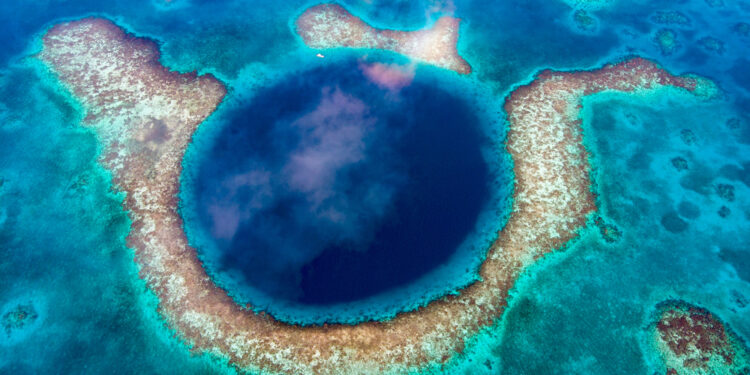The Great Blue Hole, a mesmerizing marine sinkhole located near the coast of Belize, has long captivated divers and scientists alike. This enigmatic geological formation, measuring over 300 meters across and 125 meters deep, is not only a stunning natural wonder but also a window into Earth’s past, revealing secrets from the last ice age. Join us as we delve into the depths of this awe-inspiring underwater attraction and discover the history, allure, and ecological significance of the Great Blue Hole.
A Journey Back in Time: Origins of the Great Blue Hole
The formation of the Great Blue Hole dates back to the last ice age, approximately 14,000 to 153,000 years ago, when sea levels were significantly lower than they are today. During this period, the area was once a network of limestone caves, eventually collapsing as a result of erosion caused by rainfall and the relentless movement of underground water. As the ice melted and sea levels rose, the collapsed cavern was submerged, creating the iconic sinkhole we know today.
A UNESCO World Heritage Site: The Great Blue Hole and Lighthouse Reef
The Great Blue Hole is situated within the larger Lighthouse Reef, an atoll that forms part of the Belize Barrier Reef Reserve System—a UNESCO World Heritage Site. This reef system, spanning 960 square kilometers, is the largest barrier reef in the Northern Hemisphere and the second-largest in the world, surpassed only by Australia’s Great Barrier Reef. This unique ecosystem supports an incredible array of marine life, including over 500 species of fish, 65 species of stony corals, and various marine mammals and reptiles.
An Underwater Wonderland: Diving the Great Blue Hole
The allure of the Great Blue Hole for divers is undeniable. Its crystal-clear waters, coupled with the surrounding coral reefs, create an underwater wonderland teeming with life. Diving into this massive sinkhole is a surreal experience, as the walls of the hole descend nearly vertically, plunging divers into an abyss of seemingly infinite blue.
As divers descend, they encounter a diverse range of marine life, including various species of sharks, such as Caribbean reef sharks, nurse sharks, and the elusive hammerhead shark. The stalactite formations found at a depth of approximately 40 meters are remnants of the ancient limestone caves that once existed here, offering divers a fascinating glimpse into the geological history of the Great Blue Hole.
The Great Blue Hole’s Mysteries Unveiled: Recent Exploration and Research
The Great Blue Hole has long been shrouded in mystery, with much of its depths unexplored until recently. In 2018, an ambitious expedition led by Aquatica Submarines and backed by Sir Richard Branson and Fabien Cousteau, grandson of famed oceanographer Jacques Cousteau, sought to unravel the secrets hidden within the sinkhole. Using advanced underwater technology, the team mapped the hole’s interior and discovered previously unknown features, such as a hydrogen sulfide layer and a previously uncharted chamber at a depth of 108 meters.
The data collected during this expedition has provided scientists with valuable insights into the formation and ecology of the Great Blue Hole. Researchers have also gained a better understanding of the effects of climate change on this unique ecosystem, as rising sea levels and ocean acidification pose significant threats to the Belize Barrier Reef and its inhabitants.
Conservation and the Future of the Great Blue Hole
Given its ecological importance and status as a UNESCO World Heritage Site, the conservation of the Great Blue Hole and its surrounding ecosystems is vital. The Belizean government has implemented various measures to protect this unique natural treasure, including restricting access to the site, ensuring only licensed operators can conduct diving tours. Additionally, various organizations, such as the Belize Audubon Society and Oceana, are actively working to preserve the Belize Barrier Reef and raise awareness about the threats it faces.
Climate change remains one of the most significant challenges to the Great Blue Hole’s future. The global community must continue to work together to mitigate the effects of climate change and protect the fragile ecosystems of the Belize Barrier Reef. Through international collaboration, sustainable tourism practices, and continued research, we can ensure that the Great Blue Hole remains an awe-inspiring attraction for generations to come.
The Great Blue Hole’s Timeless Allure
The Great Blue Hole, with its enigmatic beauty and rich geological history, stands as a testament to the powerful forces that have shaped our planet over millennia. For divers, it offers a once-in-a-lifetime experience, plunging into the depths of this breathtaking natural wonder. For scientists, it provides a rare opportunity to study the processes that formed this unique sinkhole and uncover the secrets hidden within its depths.
As we continue to explore and better understand the Great Blue Hole, we must also strive to protect and preserve this fragile ecosystem for future generations. By fostering a sense of responsibility and appreciation for our natural world, we can ensure that the Great Blue Hole remains an enduring symbol of Earth’s wonders and a testament to the importance of conservation.







